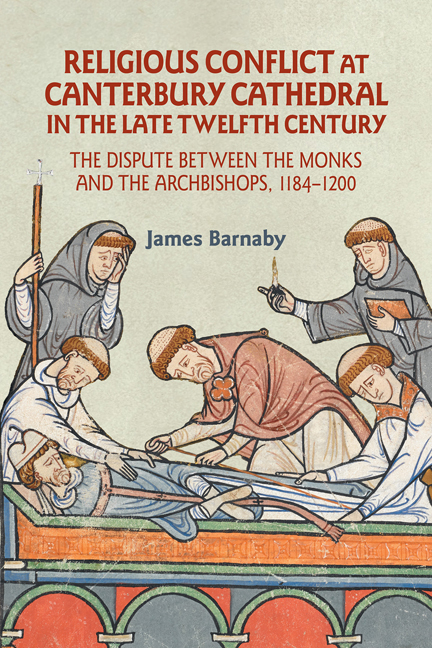 Religious Conflict at Canterbury Cathedral in the Late Twelfth Century
Religious Conflict at Canterbury Cathedral in the Late Twelfth Century Book contents
- Frontmatter
- Dedication
- Contents
- List of Maps
- Acknowledgements
- List of Abbreviations
- Introduction
- 1 The Canterbury Dispute in the Sources
- 2 Baldwin's Grand Plan (1184–November 1186)
- 3 To Rome (November 1186–July 1187)
- 4 The Hackington Dispute (August 1187–September 1189)
- 5 A New King, A Crusading Archbishop, and A Temporary Peace (September 1189–August 1191)
- 6 A New Primate (1191–3)
- 7 The Dispute Renewed (1193–1200)
- 8 After Lambeth: The Dispute in Later Centuries
- Conclusion
- Appendices
- Timeline
- Select Bibliography
- Index
- Other volumes in Studies in the History of Medieval Religion
2 - Baldwin's Grand Plan (1184–November 1186)
Published online by Cambridge University Press: 09 May 2024
- Frontmatter
- Dedication
- Contents
- List of Maps
- Acknowledgements
- List of Abbreviations
- Introduction
- 1 The Canterbury Dispute in the Sources
- 2 Baldwin's Grand Plan (1184–November 1186)
- 3 To Rome (November 1186–July 1187)
- 4 The Hackington Dispute (August 1187–September 1189)
- 5 A New King, A Crusading Archbishop, and A Temporary Peace (September 1189–August 1191)
- 6 A New Primate (1191–3)
- 7 The Dispute Renewed (1193–1200)
- 8 After Lambeth: The Dispute in Later Centuries
- Conclusion
- Appendices
- Timeline
- Select Bibliography
- Index
- Other volumes in Studies in the History of Medieval Religion
Summary
The Canterbury dispute was a complex affair. The main point of conflict concerned the erection of a new church first at Hackington and later at Lambeth, but intermixed with this conflict were also the long running disputes waged between monks and archbishops concerning lands, rights, and privileges. While it is the proposed new church that has always been given the centre ground in accounts of the quarrel, the other issues were arguably of greater importance to the monks. Although the church was a symbol of the discord between archbishop and chapter, as well as being a trigger to the prolonged period of litigation observed in the late twelfth and thirteenth centuries, it was the issues such as control of the exennia (the Christmas and Easter altar offerings from the cathedral estates) and the convent's ability to appoint its own officials, which had a greater impact on the day-to-day affairs of the monks. Yet without Baldwin's plan for Hackington, it is possible that these other problems would have merely simmered beneath the surface and would not have erupted in the twelfth century. If that had been the case, Baldwin's archiepiscopacy could have been remembered very differently.
Baldwin of Forde
Baldwin and the monks of Christ Church were at odds with each other from the beginning. He was not the monks’ choice as archbishop; they wanted either Theobald of Cluny or Odo of Battle. However, Henry II favoured Baldwin and imposed his choice on the chapter. Although not the monastic choice, Baldwin was by no means a bad person to have as a prelate. According to William of Newburgh, Henry often complained about churchmen who embraced the world with both arms. Baldwin was certainly not one of those. He was a hardworking and pious man who abandoned a promising career as a secular clerk to enter the Cistercian monastery at Forde in 1170, rising through the ranks to become abbot within a few years. In 1180, he was appointed bishop of Worcester, and four years later was translated to Canterbury. It was his actions against the Canterbury monks which gave him a poor reputation both then and now. Pope Urban III for example described him as ‘the most fervent monk, the warm abbot, the tepid bishop and the remiss archbishop’. This assessment has often been accepted by historians.
- Type
- Chapter
- Information
- Religious Conflict at Canterbury Cathedral in the Late Twelfth CenturyThe Dispute between the Monks and the Archbishops, 1184-1200, pp. 33 - 56Publisher: Boydell & BrewerPrint publication year: 2024


